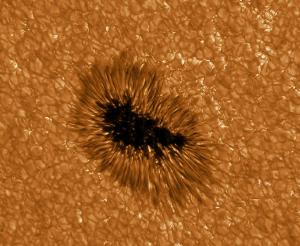Blog
Magnetic Sun
2 September 2020
 Leibniz Institute for Solar Physics (KIS)
Leibniz Institute for Solar Physics (KIS)The Sun is such a regular part of our lives that it seems like an unchanging constant. As certain sure as its rising and setting. But the Sun is also filled with ever-changing phenomena, from sunspot cycles to solar storms. The Sun’s intense magnetic field drives much of this activity.
But it isn’t easy to study the magnetic properties of the Sun. Magnetic fields aren’t visible on their own, and so must be studied through its interaction material. For example, strong magnetic fields can cause the spectral lines of a material to shift, which is one of the ways we know that strong magnetic fields cause sunspots. Missions such as NASA’s Solar Dynamics Observatory have watched arcs of plasma from solar flares follow the Sun’s magnetic field lines. But there are still many unanswered questions about the Sun’s magnetic field, so there is a need for even sharper images of the Sun’s surface.
 Leibniz Institute for Solar Physics (KIS)
Leibniz Institute for Solar Physics (KIS)This is a need the GREGOR Solar Telescope hopes to fill.1 Located in the Canary Islands, it has been observing the Sun since 2009. But it has undergone a significant redesign over the past two years and is now delivering some of the sharpest images of the Sun we’ve ever gathered. The redesign required sophisticated engineering, from computer simulations of optical paths to ensure accurate focus, to polishing mirrors to within an accuracy of 6nm. The result is a telescope that can resolve details on the Sun as small as 50 kilometers across.
Solar activity can not only affect Earth’s weather, but it can also threaten satellites and crewed space missions. The GREGOR team hopes that by learning more about the Sun’s magnetic activity, they can give us the tools we need to help protect our technology and our planet.
Kleint, Lucia, et al. “GREGOR: Optics Redesign and Updates from 2018-2020.” Astronomy & Astrophysics 641 (2020): A27. ↩︎